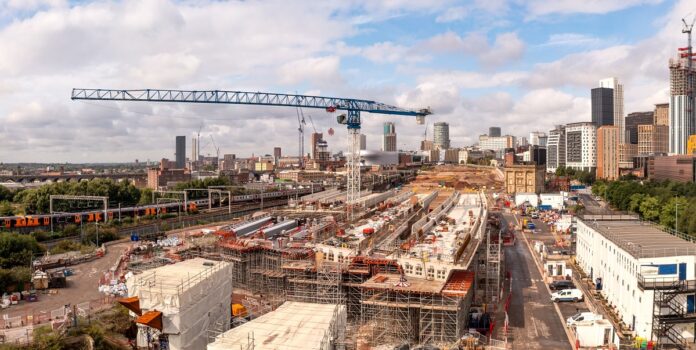High-Speed 2 (HS2), envisioned as a transformative backbone for Britain’s transport network, has long been a subject of intense scrutiny, plagued by persistent concerns over its escalating costs and a perpetually shifting timeline. The latest announcement from the Transport Secretary, confirming an unavoidable delay in train operations until at least 2033, casts a stark light on the profound challenges that have beset this monumental infrastructure undertaking since its inception.
A landmark independent review by James Stewart, commissioned by the government in October last year, has laid bare a “litany of failure” that has driven the project off course. This detailed report highlights a series of fundamental issues: a palpable lack of effective ministerial oversight and scrutiny, inadequate control exercised by HS2 Ltd over the project’s sprawling complexity, and a significant absence of effective incentives within the vast supply chain. Collectively, these systemic failings have already ballooned costs by an estimated £37 billion for Phase 1 alone, with an additional £2 billion effectively wasted on cancelled Phase 2 works – a substantial financial burden on the taxpayer.
Addressing the “Litany of Failure”
In a candid statement to Parliament, the Transport Secretary condemned this historical mismanagement, stating that without decisive action, Phase 1 risks becoming one of the most expensive railway lines in the world. In response, the government has moved swiftly to regain control. Key measures include the appointment of new leadership, the commissioning of the very review now shedding light on the issues, a reduction in financial delegations to HS2 Ltd, and a limitation on the company’s ability to act without government approval – all aimed at capping spiralling costs until a comprehensive reset is achieved. A substantial £25 billion has also been committed in the recent Spending Review to underpin these corrective actions.
The Transport Secretary outlined how the department is already addressing Mr. Stewart’s five key recommendations:
- Ministerial Oversight: The HS2 taskforce has been re-established with full senior official and ministerial attendance, aiming to restore much-needed oversight and accountability.
- Stricter Cost Control: Efforts are underway to ensure HS2 Ltd and its suppliers negotiate incentives that prioritise cost savings for taxpayers.
- Capability, Skills, and Trust: Mark Wild, the Chief Executive of HS2 Ltd, is tasked with instilling a new era of leadership, reforming the organisation to focus on building the railway safely and at the lowest reasonable cost. His proven track record in turning around the delayed Elizabeth Line into a celebrated operational success offers a blueprint for this transformation.
- Clarity on Euston Station: While the government has committed funding for tunnelling from Old Oak Common to Euston, further details on the station’s delivery are expected to be set out in due course, acknowledging a past lack of clarity.
- Lessons for Wider Transport Portfolio: The government is committed to learning from the past 15 years, vowing to deliver future infrastructure projects differently, with more detail to be provided in the upcoming 10-Year Infrastructure Strategy.
Significantly, the Prime Minister has also asked the Cabinet Secretary to investigate the broader implications of these issues for the Civil Service and wider public sector, considering whether further action or investigation is warranted.
Industry Impact
The “litany of failure” highlighted in the James Stewart review, which led to the recent announcement of HS2’s delay until at least 2033, has had, and continues to have, significant repercussions for the UK rail industry and the businesses operating within it.
These delays will cause issues for SMEs further down their work pipeline, where work banks had already been lined up. With some of these works being held, SMEs now face a rush to plug the gap – at a time where work is becoming harder to come by.
All the while, recruiting to provide the skills needed for works like this continue to prove a challenge. As over a third of rail industry workers are due to retire in the next five years, the struggle to recruit and train new individuals for works like this continues to be an issue – not only for HS2, but for all rail infrastructure projects.
Financial and Contractual Instability for Suppliers: The review specifically pointed to a “lack of effective incentives within the vast supply chain” and “inadequate control of the project by HS2 Ltd,” leading to costs ballooning by billions. For the businesses contracted to deliver HS2, this has meant an environment of significant financial uncertainty. The initial assessment by the new CEO, Mark Wild, found the project’s cost, schedule, and scope “unsustainable.” This situation has necessitated a “reset,” including the renegotiation of “HS2’s large construction contracts” and a review of HS2 Ltd’s structure and capabilities. For contractors, this means potential re-evaluation of terms, risk profiles, and potentially, the scale of their ongoing engagement, which can be unsettling.
Impact on the Broader Supply Chain: While HS2 directly supports “over 33,000 jobs” and engages “over 3,400 UK businesses,” the prolonged delays and previous cancellations of Phase 2 works (which wasted £2 billion) have undoubtedly created a ripple effect of uncertainty across this vast supply chain. Businesses that had scaled up or invested in specific capabilities for later phases of HS2 may now face difficult adjustments. The new leadership’s intent to “reset the supply chain” and ensure suppliers “negotiate incentives that ensure cost savings for taxpayers” suggests a tougher commercial environment going forward.
Skills and Workforce Challenges: The document explicitly states that “recruiting to provide the skills needed for works like this continue to prove a challenge.” It further highlights a critical demographic issue for the entire rail industry: “As over a third of rail industry workers are due to retire in the next five years, the struggle to recruit and train new individuals for works like this continues to be an issue – not only for HS2, but for all rail infrastructure projects.” HS2, as a mega-project, was intended to be a significant driver for skills development and a long-term career pipeline. However, delays and instability can undermine confidence in long-term career prospects, potentially deterring new talent from entering the sector and exacerbating existing skills shortages across the wider rail industry, impacting other vital infrastructure projects too.
Industry Confidence and Future Projects: The “litany of failure” and the substantial cost overruns, along with the repeated delays, risk eroding investor and contractor confidence not just in HS2, but potentially in other large-scale public infrastructure projects. The government’s commitment to “learning the lessons of the past 15 years to delivering infrastructure differently” and setting out more in an upcoming “10-Year Infrastructure Strategy” acknowledges this broader impact. While the overall aim of HS2 is to provide “much-needed additional capacity across the entire network” and deliver economic benefits, the turbulent journey has presented considerable challenges to the businesses that form the backbone of the UK’s rail construction and supply sector.
New Leadership and the Revised Timeline
Further reinforcing this strategic reset, the Transport Secretary confirmed that Mike Brown will assume the role of HS2 Ltd Chair, working alongside CEO Mark Wild. Their mandate is clear: to deliver a comprehensive programme reset, including a thorough review of costs and schedule, renegotiating large construction contracts, and reassessing HS2 Ltd’s skills and organisational structure. Mark Wild is expected to provide an updated assessment of revised costs and delivery timescales by the end of the year.
Mike Brown brings extensive experience, having successfully delivered major projects such as the London Underground and mainline rail for the 2012 Olympic and Paralympic Games, alongside a multi-billion-pound investment programme for London’s transport network.
Transport Secretary Heidi Alexander expressed a resolute stance: “This must be a line in the sand. This government is delivering HS2 from Birmingham to London after years of mismanagement, flawed reporting and ineffective oversight. Mark Wild and Mike Brown were part of the team, with me, that turned Crossrail into the Elizabeth Line – we have done it before, we will do it again. Passengers and taxpayers deserve new railways the country can be proud of and the work to get HS2 back on track is firmly underway.”
The initial assessment by the newly appointed CEO, Mark Wild, published this week, corroborates the severity of the situation, reiterating that the overall project in terms of cost, schedule, and scope is “unsustainable.” This assessment unequivocally concluded that there is “no route by which trains can be running by 2033 as previously planned” and issued a stark warning that costs would continue to escalate if not brought under control. This conclusion has been accepted by the Transport Secretary.
Railway Industry Association (RIA) Chief Executive Darren Caplan said: “The Railway Industry Association welcomes today’s clarification from the Government on HS2. It is now essential that HS2 Ltd’s CEO Mark Wild is given the time and space he and his team needs to carry out a ‘reset’ of the programme to deliver this project, so crucial to increasing UK rail capacity to the benefit of towns, cities, communities and the country’s economic needs for decades to come.
“RIA agrees it is important following the announcement that the lessons of the past are learnt, when it comes to avoiding the temptation to specify dates and costs prematurely on major infrastructure projects. And we support the appointment of Mike Brown CBE as HS2 Ltd’s Chair. Mike Brown has been involved at the highest levels with rail related infrastructure in the past, and we wish him well in this new role.”
The Path Forward
Despite these significant headwinds and the necessary delay, the HS2 project continues to advance physically. Over 33,000 jobs are currently supported by HS2, engaging more than 3,400 UK businesses. To date, over 44 miles of tunnels have been completed, and the impressive 2.1-mile deck of the Colne Valley Viaduct, set to be the UK’s longest railway bridge, was completed in September 2024.
Ultimately, HS2 is intended to deliver high-speed rail services between London and the West Midlands, providing much-needed additional capacity across the entire network, and offering faster, more reliable trains from London to Manchester, Liverpool, and Scotland. Economic research estimates that HS2 will be responsible for generating £10 billion and 30,000 new jobs in the West Midlands, alongside £10 billion and over 18,000 new jobs in west London.
While the path to completion for HS2 has proven more arduous and costly than initially conceived, the government’s declared “reset plan” signals a determination to impose stricter controls and restore confidence – whether that will be enacted remains to be seen. The new target of 2033 reflects a more realistic appraisal of the complexities involved, acknowledging that a truly “Great British Railway” must be delivered responsibly, even if it means a longer wait. The focus now turns to whether this renewed leadership and strategic overhaul can truly get HS2 back on track, not just in terms of construction, but in fulfilling its promise as a value-for-money investment in the UK’s future infrastructure.





